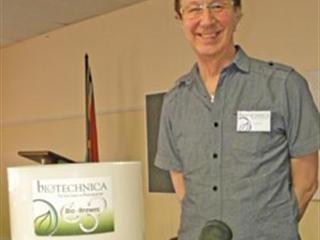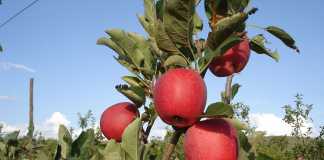
Supermarkets are putting increasing pressure on farmers to produce affordable food without the use of fungicides and pesticides. It’s a trend that is forcing farmers to produce food in an environmentally sustainable manner. Some have turned to biological agriculture, also known as bioagronomy, a biologically-based approach to plant health and crop production that encourages a synergistic relationship between plants and beneficial micro-organisms.
Soils that have been heavily cultivated over a long period are typically low in organic matter and high in calcium from years of liming. They also tend to have very low or unbalanced populations of microflora, and are highly acidic, with excessive magnesium or aluminium. As a result, they present several problems for a farmer. Fertilisers leach out quickly or get tied to excess metals, becoming inaccessible to the plant. They usually have low water retention properties.
And plants grown in them may be susceptible to disease, drought stress and nutrient deficiency. By following a bioagronomic approach, a farmer can, however, treat and repair such soils. “The end goal of bioagronomy is to produce high-yielding, healthy crops with minimal chemical inputs and pesticides,” says David Hudson, technical manager at Biotechnica, a UK-based biological services and inputs company. “You don’t have to stop using chemicals altogether, but if you select the right micro-organisms and put them in the right root zone, you can reduce the use of other inputs. This should result in cost savings.”
Taking it logically
A step-by-step approach should be followed when introducing a biological programme: wash the soil, add humates and simple sugars, and finally introduce beneficial fungi and bacteria. According to Hudson, a thriving community of mutually beneficial life forms, from bacteria and fungi to nematodes, worms and insects, helps to process and recycle nutrients as well as protect the plant against diseases.
Mycorrhizae, specialised fungi which form an extensive network of mycelial threads around the root zone, play a particularly important role. “In many cases, mycorrhizae penetrate the roots, which increases the plant’s ability to obtain nutrients and crowds out potential pathogens,” he explains. “Regular soil disturbance, together with widespread use of fungicides and herbicides, has reduced mycorrhizal presence in agricultural soils significantly. When depleted or destroyed, they need to be replaced, as they are key to reconnecting the plant to its natural biologically active environment.”
But before the micro-organisms can be reintroduced, the soil needs to be ready to receive them. “If soils have been abused over time and you put down micro-organisms, you will simply execute them. You first need to pay some attention to soil chemistry and soil structure, so that once you introduce the beneficials, they’ll have the best opportunity to thrive,” says Hudson. The first step to building healthy, fertile soil is to take a soil analysis. This indicates which nutrients are readily available to the plant. “Then,” he explains, “you can start the balancing act.”
Repairing the soil
If fertiliser salts have built up, the soil needs to be washed. “A solubiliser attaches to the excess cations so they are not freely available to the plant. When applied in combination with a wetting agent and followed by irrigation or rainfall, the salts are driven down the soil profile to balance the calcium:magnesium ratio,” says Hudson. The wash should be followed with a well-seasoned humate application.
“You need to put organic material back in the soil so that the micro-organisms will thrive,” he explains. “You don’t want to put down tons of compost, so use humates mixed with simple sugars, such as molasses, to build the soil biology and provide the base for re-establishment of an organic background. Bacteria at the bottom of the food chain thrive on simple sugars. They use it to grow and then become a food source for higher organisms. This encourages microbes into the root zone and a good proportion of nutrients you put down will stay in the root zone because it stays in the bodies of the microbes.”
After this, the soil should be ready to be inoculated with active beneficial microbes. These microbes have to be activated rapidly in warm water or in a bio-brewer with molasses or brown sugar and liquid seaweed. While the process of restoring a healthy soil biology and chemistry is progressing, it may be necessary to give the crop a boost with supplementary foliar feeds containing liquid micronutrients such as iron, zinc, sulphur, manganese, seaweed, phosphate and magnesium.
The crop’s Brix level should also be tested regularly to see how the crop is responding to the foliar treatment. This approach of grouping together certain Biotechnica products showed success with potato trials carried out over 100ha in the east of England in 2010. “When planting seed potatoes, we placed liquid phosphite fertilisers in the furrow to ensure accurate and economical applications of the fertiliser,” explains Hudson.
“Beneficial fungi and bacteria were placed in the furrow together with the phosphite, a seaweed stimulant and biohumate to establish a thriving colony of beneficial microbes in the root zone for optimum nutrient uptake by the plants. Results showed that salad potatoes planted in this manner gave significantly better yields than plots which received fertiliser only.” The cost of £60/ha (R750/ha) of biological inputs was more than offset by a significant increase in tuber numbers, which yielded an extra £400/ha to £500/ha (R5 000/ha to R6 300/ha).
And even though this was not the number one priority, the microbes also help protect against disease. 7 “Unlike full organic conversion, converting to bioagronomy can produce outstanding results in a single season and will continue to build soil biology in succeeding years. Some protective microbes can take two to three years to become fully established so we advise farmers to have chemicals on standby should the need arise to treat an infestation urgently,” concluded Hudson.
Contact Biotechnica on 031 792 9860, email [email protected] or [email protected], or visit www.biotechnica.co.uk.












